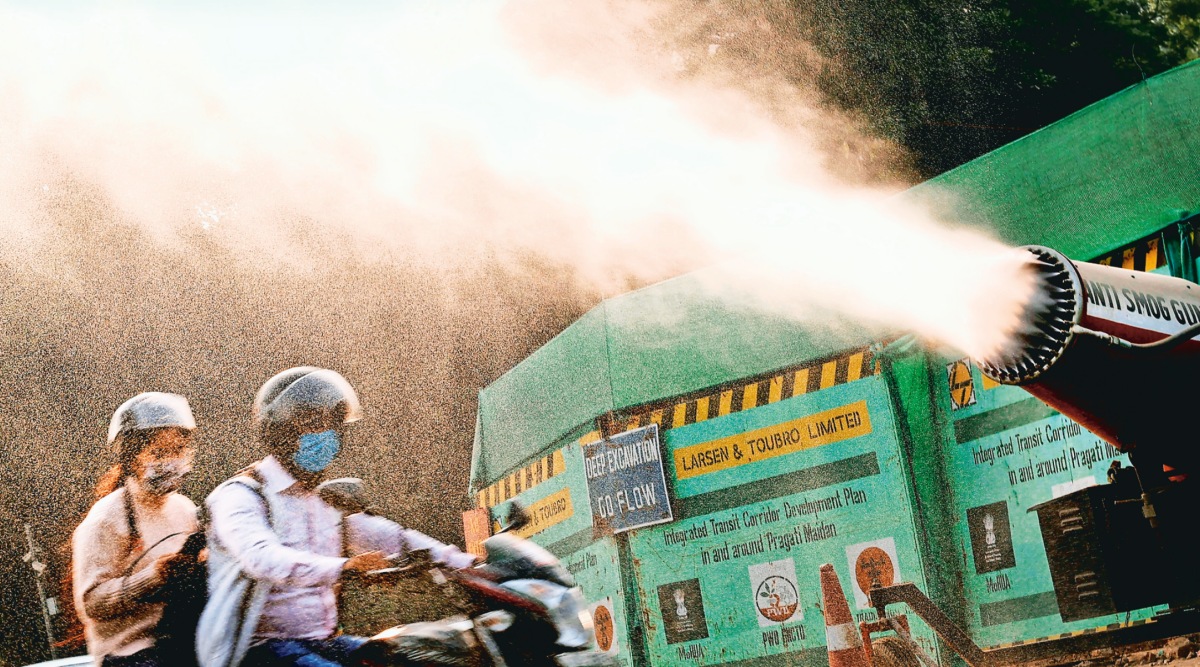 An ‘anti-smog gun’ sprays water on Tuesday, when the AQI worsened from Monday and stood at 403. (Photo: Praveen Khanna)
An ‘anti-smog gun’ sprays water on Tuesday, when the AQI worsened from Monday and stood at 403. (Photo: Praveen Khanna) Delhi’s air quality returned to the ‘severe’ category Tuesday, though the contribution of farm fires to PM2.5 levels has fallen to around 8%, according to the SAFAR forecasting system. Going by NASA satellite data, the fire count in Punjab this year is the highest since 2016 and has recently surpassed the fire count from last year.
The cumulative fire count for Punjab till November 16 stood at 74,015, higher than the 72,373 recorded last year, as per data provided by Pawan Gupta, senior scientist, Earth Sciences at the Universities Space Research Association, NASA Marshall Space Flight Centre, USA. The data is from the Visible Infrared Imaging Radiometer Suite (VIIRS), an instrument onboard the Suomi National Polar-orbiting Partnership satellite.
Data from the same instrument indicates that the fire count over the past six years has been the highest in 2016 when 84,886 counts were recorded. This is now followed by the figure recorded this year. The counts fell to 46,752 in 2017, 51,998 in 2018, and 40,528 in 2019, before climbing back up again to over 72,000 in 2020.
The fire count from Haryana this year is 8,879, according to data from VIIRS, provided by Gupta. This is the highest since 2017 when a count of 9010 was recorded. Last year, the count was 5,186 for Haryana, while the figure in 2019 was 5,735, and in 2018 was 7,501. The highest figure so far is from 2016, when 12,286 counts were recorded. On the data, Gupta said, “The fire count from the satellite is an indication of the number of satellite pixels that detected the fires. Each satellite fire pixel can represent one fire or many smaller fires, and similarly, one big fire can be seen as many fire counts in satellite data. It depends on satellite resolution, viewing geometry, fire size and intensity.”
The Central Pollution Control Board’s daily AQI bulletin provided an AQI of 403 for Delhi Tuesday with PM2.5 and PM10 as the main pollutants. This has worsened from an AQI of 353 Monday.
Fire counts have, however, been declining over the past few days. The ‘effective’ fire count from the SAFAR forecasting system on Tuesday had fallen to 1,820, down from 3,125 on Monday, and 3,445 on Sunday.
An update from the SAFAR system on Tuesday said that calm conditions and a low ventilation index are pushing the air quality into the ‘severe’ category. The ventilation index is usually determined by wind speed, humidity, temperature, and the extent to which pollutants can rise vertically and disperse. Wind speed and temperature are now low, trapping the pollutants within Delhi, said Gufran Beig, founder project director, SAFAR.
The SAFAR forecast for the next two days suggests that the intrusion of pollutants from stubble burning is unlikely over the next two days since the wind direction will be from the east of Delhi. But the air quality could stand between the ‘severe’ and the upper end of the ‘very poor’ category till November 18.
- The Indian Express website has been rated GREEN for its credibility and trustworthiness by Newsguard, a global service that rates news sources for their journalistic standards.

